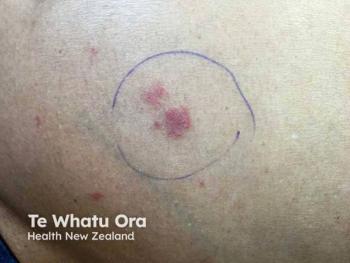
Tralokinumab Linked to Ocular Diseases in Patients with Atopic Dermatitis
Patients treated with the monoclonal antibody had increased incidences of conjunctivitis, though many of these incidences were considered mild and were resolved by the end of the study.
A new investigation from Denmark found that patients with moderate-to-severe
However, most cases of conjunctivitis were mild and transient.
In previous studies, the monoclonal antibody had been used to effectively reduce moderate-to-severe atopic dermatitis when given every 2 weeks.
The investigators, led by Marjolein de Bruin-Weller, MD, PhD, University Medical Center Utrecht, Utrecht, the Netherlands, noted that conjunctivitis had been identified as an important adverse event (AE) in this patient population since the introduction of dupilumab as a potential treatment.
In the present study, the investigators characterized the occurrence of and risk factors for conjunctivitis in a large pool of patients with moderate-to-severe atopic dermatitis from 5 phase 2 and phase 3 trials of tralokinumab.
The Methods
The investigators obtained data from 5 completed double-blind, randomized, placebo-controlled, phase 2 and phase 3 trials of tralokinumab in patients with atopic dermatitis.
Overall, there were 3 phase 3 trials (ECZTRA 1, 2, and 3), 1 phase 2 trial (ECZTRA 5) and 1 phase 2b dose-finding trial.
Eye disorders were predefined as an adverse event of special interest (AESI) in the ECZTRA trials based on potential and established areas of safety interest for monoclonal antibodies in treating atopic dermatitis.
Eye disorder AESI categories included conjunctivitis, keratoconjunctivitis, and keratitis.
Events by preferred terms were captured by AESI status (yes/no) from the adverse event form for the ECZTRA trials and classified retrospectively for the phase 2b dose-finding trial using a pre-specified MedDRA search.
Assessments of severity were made according to the investigator’s judgement and ranged from mild, moderate, or severe. Additionally, the history of allergic conjunctivitis and atopic keratoconjunctivitis was requested for each participant at screening.
The analysis featured all randomized patients exposed to tralokinumab or placebo during the initial treatment period.
A total of 2285 adults with atopic dermatitis were studied for up to 16 weeks, and Cochran-Mantel-Haenszel weights were applied to calculate adjusted adverse-event incidences.
Of the total number of patients, 1605 were treated with tralokinumab 200 mg every 2 weeks, and 680 were treated with placebo.
The Findings
Bruin-Weller and colleagues reported that incidences of conjunctivitis were higher (7.5%) with tralokinumab compared to placebo (3.2%), with most events having been mild or moderate in severity.
Of the total patient population, 147 reported at least 1 conjunctivitis AESI, with 126 patients belonging to the tralokinumab group and 21 patients in the placebo group. A total of 179 eye disorder AESI occurred during the initial treatment period, with 168 events having been classified as conjunctivitis AESI.
Overall, 78.6% and 73.9% of events resolved during the trial in the tralokinumab and placebo groups, respectively.
Regardless of treatment group, an increased incidence of conjunctivitis was associated with more severe baseline atopic dermatitis, as well as a history of allergic conjunctivitis/atopic keratoconjunctivitis and several atopic comorbidities.
To the investigators’ knowledge, this was the first study to show that some atopic comorbidities had greater influence on conjunctivitis risk than others.
Though the results showed that patients treated with tralokinumab had higher incidence rates of conjunctivitis, they believed continued research was warranted on the implications of ocular complications in patients with atopic dermatitis.
“A greater understanding of the mechanisms causing ocular complications in patients with AD, and the risk factors associated with conjunctivitis in these patients, will help identify those who are likely to develop conjunctivitis AEs with tralokinumab,” the team wrote.
The study,
This article was initially published by our sister publication
Newsletter
Like what you’re reading? Subscribe to Dermatology Times for weekly updates on therapies, innovations, and real-world practice tips.


















